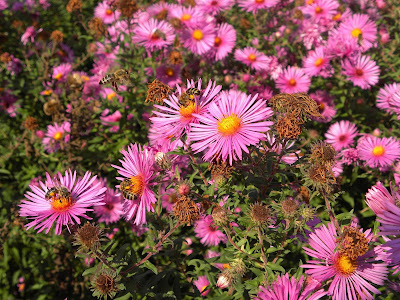 |
| NEWFS's Garden in the Woods is a fabulous resource in Framingham, MA |
Each participant brought at least one plant, natives preferred but not required. We were each assigned a group number, 1 through 4. The offerings were varied, from garden favorites quite familiar to me to native plants for special locations such as swampy areas. When everyone had arrived and our group number was called, we dashed to the plant tables and each chose one plant. We took turns choosing until the plants were gone.
I’d brought two wild gingers (Asarum canadense), two white-flowering phlox (Phlox maculatum ‘David’), a white bleeding heart (Lamprocapnos spectabilis ‘Alba’), and a goldenrod (genus Solidago) whose forebears I grew from seed years ago.
 |
| Phlox 'David" blooms in mid- to late summer |
As I placed my offerings on the tables, I realized I’d be embarrassed if nobody chose them—like not being picked at a dance. I was relieved that they all found homes by the last round. Next year I’ll pot some plants in spring so they’ll look more appealing for the swap at the end of the summer.
I came home with eight plants: a beautiful purple heuchera, a switchgrass (Panicum virgatum), a foxglove, a blue false indigo (Baptisia australis), two blazing stars (Liatris ligulistylis), a showy goldenrod (Solidago speciosa) and an Allegheny monkey flower (Mimulus ringens).
 |
| This well-grown heuchera was a prize |
Besides a fun “shopping” experience and a chance to meet like-minded gardeners, the swap met two sustainability goals for me. First, I could be sure that none of my fellow NEWFS members had been spraying their plants with neonicotinoid insecticides before bringing them to the exchange. Neonics persist for a long time, but my hope was that these plants were either seedlings from the gardeners’ original plants, or they’d been around long enough to have outlived any pesticides they might have encountered at a nursery when they were young.
 |
| Native plant enthusiasts know not to poison pollinators with neonics |
Second, a swap like this gets around the carbon cost of garden center plants. Annuals and perennials we buy locally zip around the globe before they end up in our shopping carts. Growers may buy seeds from importers who source seed all over the world. They use tissue culture products imported from South Africa, Holland, Turkey, and Poland (tissue culture converts tiny pieces of plant tissue into large numbers of genetically identical plantlets). Large plantations in Costa Rica and Ecuador with space to maintain supplies of stock plants send unrooted cuttings for regional growers in the US to root and grow to saleable size.
 |
| Plants growing from tissue cultures-photo Daderot |
To produce high-volume annuals like petunias, breeders send cuttings to specialists at a rooting station, for mass production. A broker shopping on behalf of wholesalers or garden centers fills orders with rooted cuttings from multiple rooting stations.
Unlike these international travelers, perennials from the plant swap really do come from the local area. And they’re free! A good deal all around.
 |
| This goldenrod grew up in my yard |












